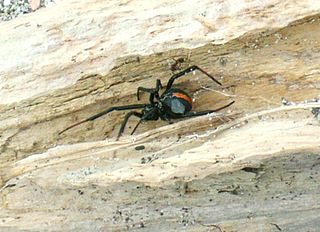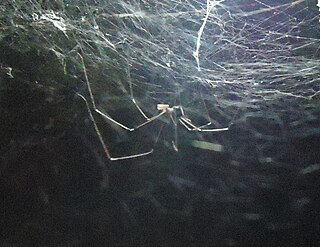
The Pholcidae are a family of araneomorph spiders. The family contains more than 1,800 individual species of pholcids, including those commonly known as cellar spider, daddy long-legs spider, carpenter spider, daddy long-legger, vibrating spider, gyrating spider, long daddy, and skull spider. The family, first described by Carl Ludwig Koch in 1850, is divided into 94 genera.

Johann Kaspar Füssli, also written Johann Caspar Fuesslins or Fuessly, was a Swiss painter, entomologist and publisher.

Pholcus is a genus of spiders of long-bodied cellar spider and allies in the family Pholcidae, with 375 described species as of January 2023.

Pholcus phalangioides, commonly known as the cosmopolitan cellar spider, long-bodied cellar spider or one of various types called a daddy long-legs spider, is a spider of the family Pholcidae. It is also known as the skull spider, since its cephalothorax is said to resemble a human skull. This is the only spider species described by the Swiss entomologist Johann Kaspar Füssli, who first recorded it in 1775. Its common name of "daddy long-legs" should not be confused with a different arachnid group with the same common name, the harvestman (Opiliones), or the crane flies of the superfamily Tipuloidea.

New Zealand has 1157 described spider species, with an estimated total fauna of 2000 species. Over 97 per cent are endemic, and the rest have been introduced through human activities or were natural wind-borne introductions.

Crossopriza lyoni is a widespread species of cellar spiders that prefer to live in or around human structures. They are commonly known as tailed cellar spiders, tailed daddy longlegs spiders, and sometimes box spiders. They all possess extremely long fragile legs that can reach up to 6 cm (2.4 in) long and a body length of that ranges from 2.5 to 7 mm. Their abdomens are distinctly squarish when viewed from the side and their carapace is more or less circular when viewed from above. They also possess two kinds of sound-producing organs and have six eyes.

Pholcus opilionoides is a species of spider in the family Pholcidae found in Europe, Egypt, the Caucasus and possibly Iran.

Pholcus ponticus is a species of cellar spider found from Bulgaria to China.
Pholcus velitchkovskyi is a cellar spider species found in Russia, Ukraine and Iran.

Engyodontium is a genus of fungi belonging to the group Hyphomycetes and contains about 6 species. This fungus was formerly included in Beauveria, but is now recognized as a distinct genus.
Wanniyala is a genus of cellar spiders native to Sri Lanka, first described by Huber & Benjamin in 2005. They have six eyes and four pair of legs and grow up to 2 mm in length. The abdomen is globular and males have a distinctive distal hinged sclerite on the procursus of genitalia. The name is derived from the Sri Lankans native to the island that the first spiders were found on- the Vedda people- and their surname Wanniyala-Aetto.

Pholcus manueli, known generally as the cellar spider or daddy longlegs, is a species of cellar spider in the family Pholcidae. It is found in Russia, Turkmenistan, China, Korea, Japan, and the United States.
Tissahamia is a genus of southeast Asian cellar spiders named after Wanniyalaeto chief Uru Warige Tissahami. It was erected in 20180 for several species transferred from Pholcus after a molecular phylogenetic study of the Calapnita-Panjange clade of Pholcidae. They have long, thin abdomens that bend upward near the end. They also have six eyes, three on each of two eye stalks.
Kelabita is a small genus of southeast Asian cellar spiders. The genus was erected in 2018 for two species transferred from Pholcus after a molecular phylogenetic study of Pholcidae. It is named after the Kelabit, an ethnic group native to Borneo. They build domed webs up to 2 metres above the ground, and can be distinguished by unique sclerotization, including a partially sclerotized embolus. As of April 2022 it contains only two species: K. andulau and K. lambir.

Kintaqa is a genus of southeast Asian cellar spiders erected in 2018 for five species moved from Pholcus after a molecular phylogenetic study. They are medium-sized spiders, distinguished by their unique enlarged shape of fourth segment of pedipalps.
Meraha is a genus of southeast Asian cellar spiders. The genus was erected in 2018 for two species transferred from Pholcus after a molecular phylogenetic study of Pholcidae. The name is derived from the Malay "merah", meaning "red", referring to the reddish-orange hue of pedipalps. They are average sized cellar spiders with a cylindrical abdomen, and they build domed webs .5 to 2 metres above the ground.
Muruta is a small genus of southeast Asian cellar spiders named after the Murut people. It was erected in 2018 for two species transferred from Pholcus after a molecular phylogenetic study of Pholcidae. They are average size for cellar spiders with relatively long legs, the first legs averaging 35 to 40 millimetres long. Males can be distinguished from other species by hairless, flat sclerites on their chelicerae, and females can be distinguished by three-layered telescopic tubes in their genital structure. As of April 2022 it contains only two species, both native to northern Borneo: M. bario and M. tambunan.
Paiwana is a small genus of east Asian cellar spiders named after the Paiwan people. The genus was erected in 2018 for two species transferred from Pholcus after a molecular phylogenetic study of Pholcidae. Males are distinguished by unique sclerotized modifications to the chelicerae, and females by the unique triangular epigynum shape. As of April 2022 it contains only two species, both native to Taiwan: P. chengpoi and P. pingtung.
Teranga is a genus of southeast Asian cellar spiders erected in 2018 for four species transferred from Pholcus after a molecular phylogenetic study of the Calapnita-Panjange clade of Pholcidae. They are medium-sized cellar spiders, averaging 3.5 to 4.5 millimetres in length, with longer legs, the first pair reaching 30 to 40 millimetres long. The abdomen is long and thin, with a slight upward bend near the end. The name is derived from the Malay "terang", meaning "bright", referring to their light color.

Pholcus nagasakiensis is a species of cellar spider in the genus Pholcus. It is found in Japan.











